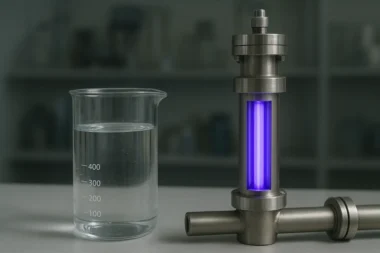Introduction
Nanobubbles, defined as bubbles with diameters on the order of hundreds of nanometers, have emerged as a cutting-edge technology with significant potential in the field of water purification. Unlike conventional bubbles, nanobubbles possess unique physical and chemical properties that make them particularly effective in various water treatment applications. The utilization of nanobubbles in water purification represents a promising advancement, offering enhanced efficiency in contaminant removal, improved oxygenation, and support for biological processes. This introduction explores the transformative potential of nanobubbles as a novel and innovative solution for achieving superior water quality in diverse industrial, environmental, and municipal contexts.
Working principle of nanobubble-generating devices
1. Ultrasonic Nanobubble Generators:
- Cavitation Process: Ultrasonic nanobubble generators utilize high-frequency sound waves (ultrasonic waves) to induce a phenomenon known as cavitation.
- Transducer: The device includes an ultrasonic transducer that emits waves into the liquid, creating alternating high- and low-pressure regions.
- Formation of Microbubbles: In the low-pressure regions, small gas pockets or nuclei are formed due to the reduction in pressure.
- Collapse and Nanobubble Formation: When these gas pockets experience high pressure, they rapidly collapse, creating shockwaves. This collapse results in the formation of nanobubbles due to the release of gas.
2. Electrolytic nanobubble generators:
- Electrolysis Process: Electrolytic nanobubble generators rely on the electrolysis of water to produce oxygen or other gases.
- Electrodes: Electrodes are immersed in the liquid (usually water), and an electric current is applied.
- Gas Evolution: Oxygen or other gases are evolved at the electrodes due to the electrolysis of water.
- Nanobubble Formation: The electrolytic process’s agitation causes the evolved gases to form nanobubbles.
3. Controlled Cavitation and Nanobubble Stability:
- Parameter Adjustment: Both ultrasonic and electrolytic generators allow for the adjustment of parameters such as frequency, intensity, and current to control the size and stability of nanobubbles.
- Closed-Loop Systems: Some advanced nanobubble generators incorporate closed-loop systems that monitor real-time conditions and automatically adjust parameters for optimal nanobubble production and stability.
4. Surfactants (optional):
- Stabilization: In some cases, surfactants may be added to the liquid to further stabilize the nanobubbles and prevent coalescence or aggregation.
- Dosage Control: Careful control of surfactant dosage is essential to avoid undesirable effects on water quality.
5. Continuous Generation:
- Sustained Operation: Nanobubble generators are designed for continuous operation to provide a consistent supply of nanobubbles.
- Batch or Continuous Flow: The generator may operate in batch mode or as part of a continuous flow system, depending on the application.
6. Delivery System:
- Introduction into Water: Once generated, nanobubbles are introduced into the target liquid, typically water, through a delivery system.
- Uniform Dispersion: The delivery system ensures uniform dispersion of nanobubbles throughout the water for effective treatment.
The working principles of nanobubble-generating devices leverage physical processes such as cavitation or electrolysis to create stable nanobubbles in a controlled manner. The ability to adjust parameters and the incorporation of advanced monitoring systems contribute to the precision and efficiency of nanobubble production for applications in water purification and beyond.
Parameters for generating nanobubbles
1. Frequency:
- The number of oscillations per unit of time is measured in hertz (Hz).
- Ultrasonic frequencies typically used for nanobubble generation range from 20 kHz to several megahertz.
- Higher frequencies lead to smaller nanobubbles due to increased cavitation.
2. Intensity:
- The amplitude or power of the ultrasonic waves is measured in Watts per square centimeter (W/cm2).
- Intensity influences cavitation activity, affecting nanobubble size and concentration.
- Higher intensity levels result in more significant cavitation, leading to smaller nanobubbles.
3. Duration:
- The length of time ultrasonic waves or electrolysis are applied.
- Longer durations contribute to sustained cavitation and continuous nanobubble generation.
- Optimal duration depends on the specific application and desired nanobubble characteristics.
4. Gas Type and Pressure:
- Type of gas used for infusion and its pressure.
- Common gases include oxygen, nitrogen, or air.
- Gas pressure influences nanobubble size and stability; higher pressures can result in smaller bubbles.
5. Liquid Properties:
- Characteristics of the liquid medium (e.g., water, wastewater)
- Temperature affects the solubility of gases and, consequently, nanobubble stability.
- Water composition, including impurities and additives, can impact nanobubble formation.
6. Electrolysis Conditions:
- Parameters like current, voltage, and electrode material in electrolytic processes.
- Electrolysis involves the dissociation of water into oxygen and hydrogen gases.
- Electrode material influences gas evolution; for instance, platinum electrodes are common.
7. Gas Infusion Rate:
- Rate at which gas is infused into the liquid, measured in volume per unit time.
- Controlling the infusion rate is crucial for achieving the desired nanobubble concentration.
- Infusion methods include spargers, diffusers, or direct injection.
8. Control Systems:
- Automated systems for real-time monitoring and adjustment.
- Closed-loop control systems use sensors to monitor nanobubble characteristics.
- Adjustments are made based on real-time feedback to maintain optimal conditions.
9. Water Quality:
- Characteristics of the water being treated.
- Water quality parameters such as pH, conductivity, and dissolved solids can impact nanobubble stability.
- Pre-treatment processes may be required to remove impurities.
10. Safety Measures:
- Precautions to prevent undesirable outcomes during nanobubble generation.
- Safety measures include proper ventilation, emergency shut-off systems, and equipment safeguards.
- Handling gases like oxygen requires adherence to safety protocols.
Conclusion
The frequency parameter is a crucial determinant in nanobubble generation. Its influence on bubble size, stability, and energy dynamics underscores its significance in tailoring the process for specific applications. The adjustability of ultrasonic frequencies provides a versatile tool for optimizing nanobubble characteristics. As nanotechnology progresses, the nuanced control of frequency, along with other parameters, promises continued advancements in diverse fields, from water treatment to biomedical research and industrial applications. The ongoing exploration of nanobubble science holds the potential for innovative solutions and enhanced efficiencies in various domains.



